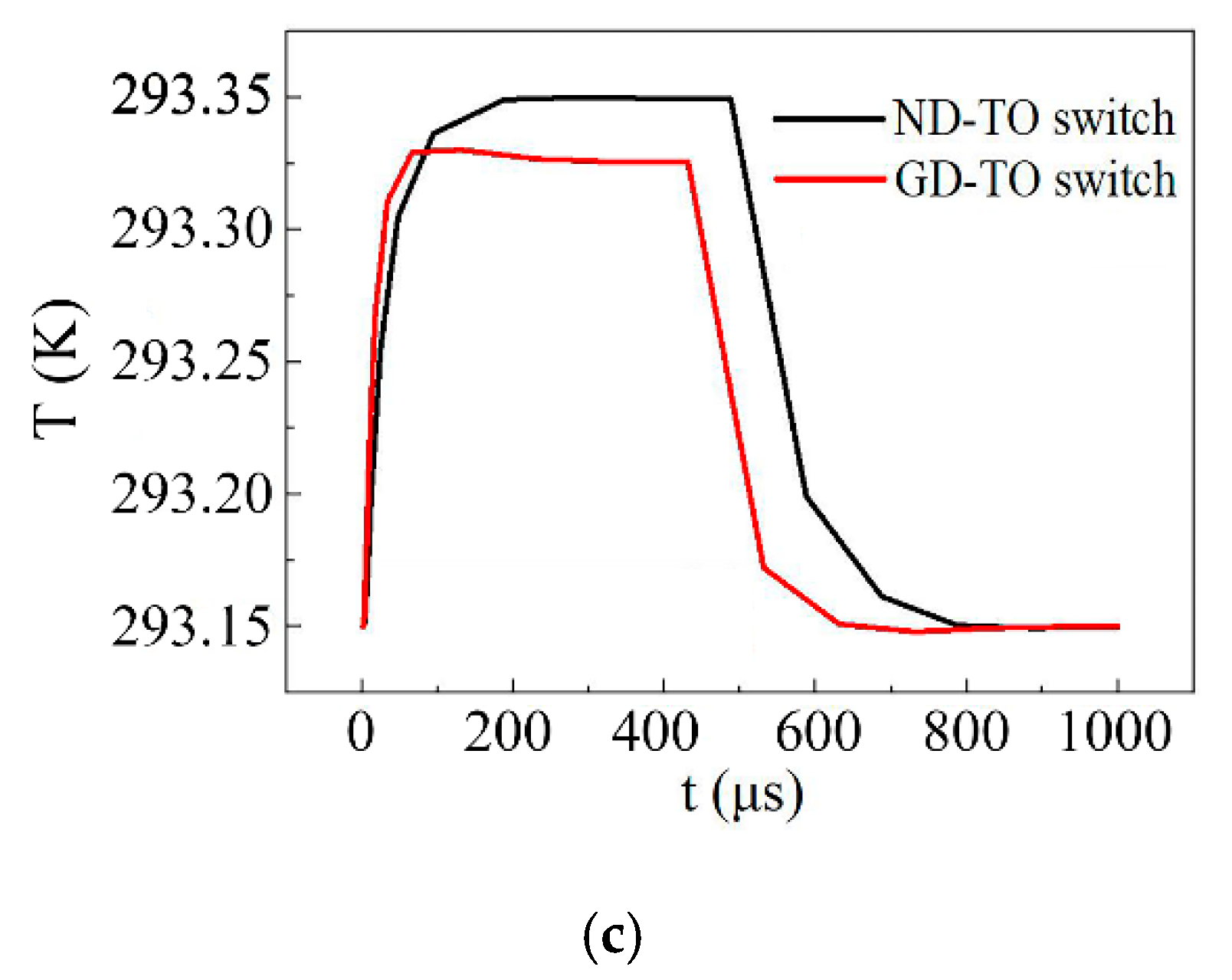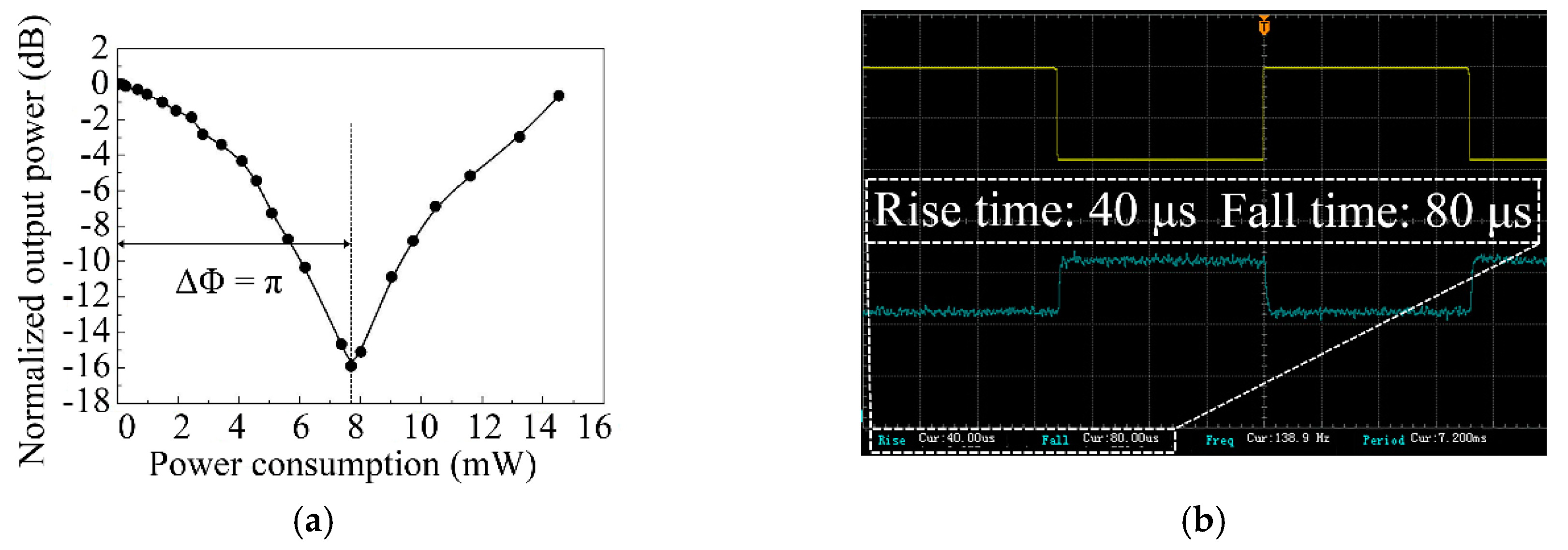Dispersed-Monolayer Graphene-Doped Polymer/Silica Hybrid Mach-Zehnder interferometer (MZI) Thermal Optical Switch with Low-Power Consumption and Fast Response
Abstract
:1. Introduction
2. Materials and Methods
2.1. Thermal Conductivity of Graphene-Doped PMMA Material
2.2. Application of Composite Material in TO Switch Field
2.2.1. Device Structure and Light Field Distributions
2.2.2. Device Performance Simulation
3. Results
3.1. Fabrication and Characterizations
3.2. Power Consumption and Response Time
4. Conclusions
Author Contributions
Funding
Conflicts of Interest
References
- Lu, H.; Liu, X.; Wang, L.; Gong, Y.; Mao, D. Ultrafast all-optical switching in nanoplasmonic waveguide with Kerr nonlinear resonator. Opt. Express 2011, 19, 2910–2915. [Google Scholar] [CrossRef] [PubMed]
- Sato, K. Realization and application of large-scale fast optical circuit switch for data center networking. J. Lightwave Technol. 2018, 36, 1411–1419. [Google Scholar] [CrossRef]
- De Dobbelaere, P.; Falta, K.; Gloeckner, S.; Patra, S. Digital MEMS for optical switching. IEEE Commun. Mag. 2002, 40, 88–95. [Google Scholar] [CrossRef]
- Marxer, C.; de Rooij, N. Micro-opto-mechanical 2 × 2 switch for single-mode fibers based on plasma-etched silicon mirror and electrostatic actuation. J. Lightwave Technol. 1999, 17, 2–6. [Google Scholar] [CrossRef]
- Enami, Y.; Mathine, D.; DeRose, C.; Norwood, R.; Luo, J.; Jen, A.; Peyghambarian, N. Hybrid electro-optic polymer/sol-gel waveguide directional coupler switches. Appl. Phy. Lett. 2009, 94, 213513. [Google Scholar] [CrossRef]
- Tian, F.; Hermann, H. Interchannel interference in multiwavelength operation of integrated acousto-optical filters and switches. J. Lightwave Technol. 1995, 13, 1146–1154. [Google Scholar] [CrossRef]
- Zhu, S.; Lin, B.; Lo, G.; Kwong, D. High-performance to switches on compact cu-dielectric-si hybrid plasmonic WRRs. IEEE Photonics Technol. Lett. 2014, 26, 2495–2498. [Google Scholar]
- Espinola, R.; Tsai, M.; Yardley, J.; Osgood, R. Fast and low-power thermooptic switch on thin silicon-on-insulator. IEEE Photonics Technol. Lett. 2003, 15, 1366–1368. [Google Scholar] [CrossRef]
- Cao, Z.; Jin, L.; Liu, Y.; Jiang, Z.; Zhang, D. Crosslinkable fluorinated hyperbranched polyimide for thermo-optic switches with high thermal stability. J. Appl. Polym. Sci. 2013, 127, 607–611. [Google Scholar] [CrossRef]
- Lin, X.; Ling, T.; Subbaraman, H.; Guo, L.; Chen, R. Printable thermo-optic polymer switches utilizing imprinting and ink-jet printing. Opt. Express 2013, 21, 2110–2117. [Google Scholar] [CrossRef]
- Keil, N.; Weinert, C.; Wirges, W.; Yao, H.; Yilmaz, S.; Zawadzki, C.; Schneider, J.; Bauer, J.; Bauer, M.; Lösch, K.; et al. Thermo-optic vertical coupler switches using hybrid polymer/silica integration technology. Electron. Lett. 2000, 36, 430–431. [Google Scholar] [CrossRef]
- Gao, Y.; Xu, Y.; Ji, L.; Sun, X.; Yi, Y.; Wang, F.; Wu, Y.; Zhang, D. Thermo-optic mode switch based on an asymmetric mach-zehnder interferometer. IEEE Photonics Technol. Lett. 2019, 31, 861–864. [Google Scholar] [CrossRef]
- Liang, L.; Qv, L.; Zhang, L.; Zheng, C.; Sun, X.; Wang, F.; Zhang, D. Fabrication and characterization on an organic/inorganic 2×2 Mach–Zehnder interferometer thermo-optic switch. Photonics Nanostructures Fundam. Appl. 2014, 12, 173–183. [Google Scholar] [CrossRef]
- Xu, Q.; Jiang, M.; Niu, D.; Wang, X.; Wang, L.; Chiang, K.; Zhang, D. Fast and low-power thermo-optic switch based on organic-inorganic hybrid strip-loaded waveguides. Opt. Lett. 2018, 43, 5102–5105. [Google Scholar] [CrossRef] [PubMed]
- Sun, S.; Niu, D.; Sun, Y.; Wang, X.; Yang, M.; Yi, Y.; Sun, X.; Wang, F.; Zhang, D. Design and fabrication of all-polymer thermo-optic variable optical attenuator with low power consumption. Appl. Phys. A 2017, 123, 1–6. [Google Scholar] [CrossRef]
- Ni, G.; Wang, L.; Goldflam, M.; Wagner, M.; Fei, Z.; McLeod, A.; Liu, M.; Keilmann, F.; Özyilmaz, B.; Castro Neto, A.; et al. Ultrafast optical switching of infrared plasmon polaritons in high-mobility graphene. Nat. Photonics 2016, 10, 244–247. [Google Scholar] [CrossRef]
- Chang, Z.; Chiang, K. Ultra-broadband mode filters based on graphene-embedded waveguides. Opt. Lett. 2017, 42, 3868–3871. [Google Scholar] [CrossRef]
- Sun, Y.; Cao, Y.; Yi, Y.; Tian, L.; Zheng, Y.; Zheng, J.; Wang, F.; Zhang, D. A low-power consumption MZI thermal optical switch with a graphene-assisted heating layer and air trench. RSC Advances 2017, 7, 39922–39927. [Google Scholar] [CrossRef]
- Davis, H.; Valencourt, L.; Johnson, C. Transport Processes in Composite Media. J. Am. Ceram. Soc. 1975, 58, 446–452. [Google Scholar] [CrossRef]
- Lewis, T.; Nielsen, L. Dynamic mechanical properties of particulate-filled composites. J. Appl. Polym. Sci. 1970, 14, 1449–1471. [Google Scholar] [CrossRef]
- Pongsa, U.; Somwangthanaroj, A. Effective thermal conductivity of 3,5-diaminobenzoyl-functionalized multiwalled carbon nanotubes/epoxy composites. J. Appl. Polym. Sci. 2013, 130, 3184–3196. [Google Scholar] [CrossRef]
- Igamberdiev, K.T.; Yuldashev, S.U.; Cho, H.D.; Kang, T.W.; Rakhimova, S.M.; Akhmedov, T.K. Study of the thermal conductivity of ZnO nanowires/PMMA composites. J. Korean Phys. Soc. 2012, 60, 1513–1516. [Google Scholar] [CrossRef]
- Chang, Z.; Chiang, K. Experimental verification of optical models of graphene with multimode slab waveguides. Opt. Lett. 2016, 41, 2129–2132. [Google Scholar] [CrossRef] [PubMed]
- Cao, Y.; Lin, B.; Sun, Y.; Che, X.; Yi, Y.; Wang, F.; Zhang, D. Thermal tuning of graphene-embedded waveguide filters based on the polymer-silica hybrid structure. RSC Advances 2018, 8, 30755–30760. [Google Scholar] [CrossRef]
- Cheng, R.; Zhang, D.; Wang, J.; Wang, C.; Gao, F.; Sun, X.; Shi, Z.; Cui, Z.; Chen, C. Fluorinated photopolymer cascaded MMIbased integrated optical waveguide switching matrix with encoding functions. Opt. Express 2019, 27, 12883. [Google Scholar] [CrossRef] [PubMed]
- Chang, Z.; Chiang, K.S. All-optical loss modulation with graphene-buried polymer waveguides. Opt. Lett. 2019, 44, 3685–3688. [Google Scholar] [CrossRef]
- Hida, Y.; Hida, Y.; Onose, H.; Onose, H.; Imamura, S.; Imamura, S. Polymer waveguide thermooptic switch with low electric power consumption at 1.3 μm. IEEE Photonics Technol. Lett. 1993, 5, 782–784. [Google Scholar] [CrossRef]







© 2019 by the authors. Licensee MDPI, Basel, Switzerland. This article is an open access article distributed under the terms and conditions of the Creative Commons Attribution (CC BY) license (http://creativecommons.org/licenses/by/4.0/).
Share and Cite
Cao, Y.; Zhang, D.; Yang, Y.; Lin, B.; Lv, J.; Yang, X.; Zhao, H.; Wang, F.; Li, B.; Yi, Y. Dispersed-Monolayer Graphene-Doped Polymer/Silica Hybrid Mach-Zehnder interferometer (MZI) Thermal Optical Switch with Low-Power Consumption and Fast Response. Polymers 2019, 11, 1898. https://doi.org/10.3390/polym11111898
Cao Y, Zhang D, Yang Y, Lin B, Lv J, Yang X, Zhao H, Wang F, Li B, Yi Y. Dispersed-Monolayer Graphene-Doped Polymer/Silica Hybrid Mach-Zehnder interferometer (MZI) Thermal Optical Switch with Low-Power Consumption and Fast Response. Polymers. 2019; 11(11):1898. https://doi.org/10.3390/polym11111898
Chicago/Turabian StyleCao, Yue, Daming Zhang, Yue Yang, Baizhu Lin, Jiawen Lv, Xianwang Yang, Haowen Zhao, Fei Wang, Baohua Li, and Yunji Yi. 2019. "Dispersed-Monolayer Graphene-Doped Polymer/Silica Hybrid Mach-Zehnder interferometer (MZI) Thermal Optical Switch with Low-Power Consumption and Fast Response" Polymers 11, no. 11: 1898. https://doi.org/10.3390/polym11111898





